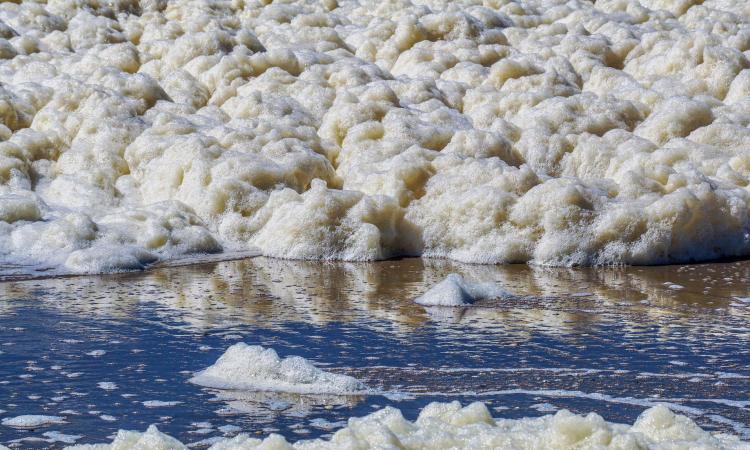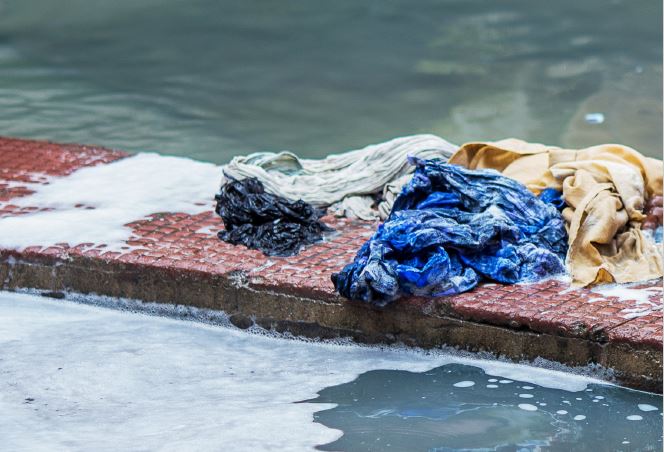
It’s ironic that detergents, which are meant for cleaning, flow into water bodies and pollute them with chemicals. A study released recently by Delhi-based non-profit Toxics Link, ‘Dirty Trail: Detergent to Water Bodies’, has found startling levels of the toxic chemical nonylphenol in detergents as well as in river water in India.
The study points to the dangers of nonylphenol, which is banned in several countries or is being phased out. It states that nonylphenol “is a xenobiotic and an endocrine disrupting chemical used largely in the production of nonylphenol ethoxylates”, which is “extensively used as a surfactant and in other industrial applications as well as in day to day consumer products.”
Exposure to nonylphenol through water, soil and food crops is dangerous
Nonylphenol ethoxylate generally breaks down to nonylphenol in natural environmental conditions, entering the ecosystem. It also enters into “the food chain, where it bio-accumulates and can pose serious environmental and health risks”, the study says.The chemical is found to have a number of reproductive and hormonal effects on people that have been exposed to it. It has been detected in human breast milk, blood, and urine and is associated with reproductive and developmental effects in rodents.
The study conducted in association with the Department of Chemical Engineering, Indian Institute of Technology (IIT), Guwahati, found nonylphenol in all the samples of detergent, river and lake water. It analysed twelve detergent samples, all of which detected nonylphenol in concentrations varying between 0.82 and 11.92 weight percentage. Others had concentration of 2.06, 11.5, 4.29, 1.15, 0.82, 0.93, 1.43, 0.25, 0.91, 1.04 and 1.31 by weight percentage.
The detergent samples were taken from the local markets of Delhi and water from six rivers - Garh Ganga and Hindon in Uttar Pradesh, Krishnan in Andhra Pradesh, Tapti in Gujarat, Bandi in Rajasthan, Mahanadi in Odisha and Ambazari lake in Nagpur.
|
Concentration of nonylphenol in different rivers |
||
|
Sample |
Location |
Nonylphenol (ppm) |
|
Tapti point I |
Gujarat |
10.60 |
|
Tapti point II |
Gujarat |
13.09 |
|
Krishna point I |
Andhra Pradesh |
11.38 |
|
Krishna point I |
Andhra Pradesh |
14.72 |
|
Bandi point I |
Rajasthan |
14.99 |
|
Bandi point II |
Rajasthan |
41.27 |
|
Garh Ganga point I |
Uttar Pradesh |
9.22 |
|
Garh Ganga point II |
Uttar Pradesh |
14.76 |
Note: Point II of the river indicates greater anthropogenic activity than in point I. The study found that the more the anthropogenic activities, the more the concentration of nonylphenol.

The concentration in the detergent samples was found to be very high in products of international corporations, while ironically, they have declared their products to be nonylphenol-free in other countries. This points to a double standard considering that studies confirm the human health impacts of nonylphenol, especially the fact that it may be carcinogenic.
The USA, the European Union and China have all phased out the chemical completely, while Denmark has completely banned the use of nonylphenol ethoxylates in its textile and leather industries. The EU has restricted the use of the chemical in products and product formulations to 0.01% in textile and other industries.
The Bureau of Indian Statistics (BIS) has set the standard of phenolic compounds for drinking water (0.001 mg/L) and surface water (5.0 mg/L).However unlike other countries, India has prohibited the use of nonylphenol in cosmetic products since 2009, but it still lacks a regulation on its use in surfactants, other consumer products or specific standards for the chemical in drinking water and surface water.
Efforts are ongoing globally to restrict the use of the chemical in drinking water. Canada has set the standard of nonylphenol at 1.0 microgram per liter (µg/L) in freshwater while the US Environmental Protection Agency (EPA) has established water quality criteria for nonylphenol at 6.6 µg/L for acute exposures and 1.7 µg/L for chronic exposures. In India, “there is a lack of public information available on the possible impacts of the chemical and the ways to minimize the risks associated with it,” the study says.
Key findings of the study are:
- Nonylphenol was found in very high quantity in all the detergent samples;
- The concentration of nonylphenol was found in detergent samples ranging from 0.25 weight percent (wt%) to 11.92 wt%;
- Nonylphenol was detected in notably high quantity in all the river samples;
- Nonylphenol concentration was found to be 14.76 ppm in Garh Ganga;
- The highest level of nonylphenol was found in the water sample from the Bandi river in Rajasthan i.e. 41.27 part per million (ppm); and
- Despite many corporations claiming that they do not use nonylphenol, the study confirmed the presence of high quantity of the chemical in the products sold by their Indian subsidiaries.
The study finds that the concentration of nonylphenol is as much as eight times more than the prescribed BIS standard for phenolic compounds and over 100 times as compared to the USEPA safety standard for water quality criteria.
The study has proposed the following recommendations:
- Banning the use of nonylphenol in detergents, one of the major sources of environmental contamination.
- Generation of data to assess the possible impacts of the chemical on human health and environment.
- Creating an inventory of the usage of nonylphenol in different sectors in the country.
- Carrying out substantial research studies on the presence of nonylphenol in water bodies and develop policy to denominate the chemical from the environment.
- Revising industrial effluent standards to prevent the entry of NP in the environment.
- Bringing standards on nonylphenol in drinking water and in food to protect human health and the environment.
- Promulgating suitable regulations in the country to phase out the chemical in other products as well.
- Initiating a legal action against the corporations for practicing double standard based on the polluter pay principle.
- Need to check the nonylphenol presence in drinking water as well the possible revision of drinking water standard at par with the global standard in context of nonylphenol.
- Adoption of technology to decontaminate nonylphenol in water
- Assessment and adoption of available alternatives.
The study report can be downloaded here